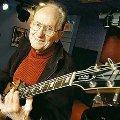Les Paul single-handedly changed the course of music when he developed his solid body guitar, and discovered a new way to record voices and instruments. Paul became known as the "Wizard of Waukesha," by people in his Wisconsin home town. Born Lester William Polfuss, he was self-taught on guitar, and loved to experiment with electronic equipment. He performed country music at a local restaurant when he was 10 years old, and by age 13, had built his own broadcasting station and recording device. He played and traveled with country bands and even hosted his own radio show in Chicago.
When he moved to California in the early-1940s, Les started experimenting with electronics for guitar. He fashioned a solid body guitar from one piece of wood, and attached some electronic devices to amplify the sound. His theory was that the devices and body should remain firm, allowing the strings to vibrate longer and sustain a sound.
Paul also invented the 8-track recording technique known as multi-track recording, and over-dubbing, where a melody was recorded on one track, and then the harmony was re-recorded along with the melody on another track. Paul recalled working on the idea in his home recording studio.
"I got the idea for the multi-track from my mom, who said, 'You know, Lester, you sound like everybody else and everybody else is sounding like you. Since you went to the electric guitar, everybody is copying you, and you ought to do something about it,'" he said. "So I did do something about it - go home and lock myself in my garage, in my recording studio, and not going to come out until I sound so different that I make my mother happy and she knows me from anybody else. And for two years, I locked myself in that garage and no one knew what I was striving for." Les Paul designed other equipment to capture sounds and convert them to electronic signals. All of his inventions, along with his accomplished guitar style, had a lasting effect on the music business. His new techniques were showcased in hit songs such as "How High The Moon," a duet with his then-wife, Mary Ford. In the early-1950s, Les Paul and Mary Ford had other Top 10 hits, including "Vaya Con Dios," "Mockin' Bird Hill," and "The World Is Waiting For The Sunrise." The Gibson Guitar Company debuted its first Les Paul model in 1952, which later became the instrument of choice for rock musicians such as Eric Clapton and Led Zeppelin's Jimmy Page. Soon after, the first multi-track tape recorder, also designed by Les Paul, was marketed.
Recognized for his skill as an inventor, Paul was asked to help design and construct the famous Capitol Records studios in Hollywood, California, the first-ever made for high fidelity recordings. The studios are known around the world for their technical and sound quality, and have hosted such great talents as Frank Sinatra, Barbra Streisand, Ella Fitzgerald and Judy Garland. Les Paul recalled that there were a few unexpected construction problems.
"We made some goofs [mistakes] that were kind of interesting," he said. "We didn't make the hallway wide enough to get a piano down, we forgot to put AC [electrical] outlets in one of the studios, and we completely forgot the echo chambers, so we had to put them under the parking lot. We did make errors, but we had a lot of fun doing it. Being the first ones to do something that gigantic was very exciting." Les Paul teamed with another guitar legend, Chet Atkins, for the album "Chester and Lester," which combined Atkins' country picking and Paul's jazzy, electric style. That collection won a Grammy Award in 1976 for Best Country Duo. Paul won two more Grammy Awards for his album "Les Paul And Friends: American Made World Played," recorded when he was 90 years old. Les Paul was inducted into the Rock and Roll Hall Of Fame in 1988, and was also a member of the Grammy Hall of Fame, Songwriters Hall Of Fame and National Inventors Hall Of Fame.
Since 1983, Les Paul had a regular engagement one-night-a-week at a New York City nightclub. He always believed that if he made his audiences happy, they would keep coming back to see him.
"The most important thing is to give them what they came down to hear," he said. "Some people are so fixed in their ways that they wouldn't play commercial. First of all, you train yourself and you have the God-given talent that you can do it, and that is that you can play jazz if they want jazz, and play country if they want country, and classical if you're that gifted." In his career of more than 75 years, Les Paul earned 22 gold records, designed a revolutionary guitar, and invented countless techniques that are used by musicians in recording studios today.
Les Paul, the Wizard of Waukesha, dead at the age of 94.
I'm Doug Levine.

